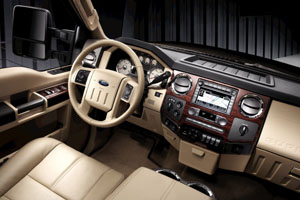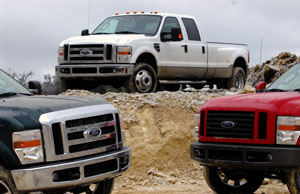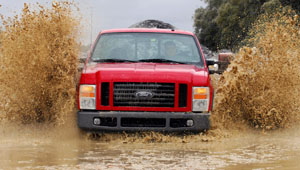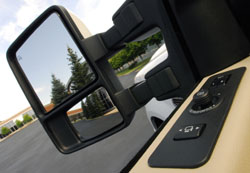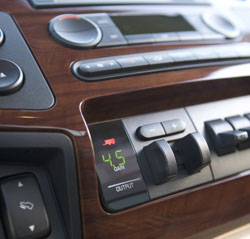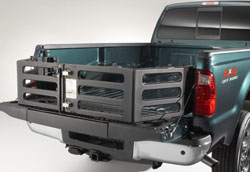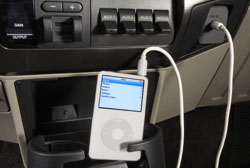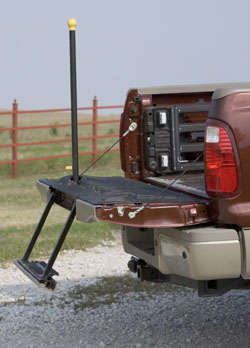
The 2008 GMC Canyon lineup builds on the significant product enhancements that were implemented in 2007, including two all-new, more powerful engines. As a result, changes for ’08 are minimal and include halogen front fog lamps on all models and the addition of three new exterior colors: Red Orange Metallic, Carbon Black Metallic and Dark Steel Gray Metallic. Unchanged is the stylish, capable package that truck customers have come to expect from Canyon.
2008 GMC Canyon SLT Crew Cab2008 GMC Canyon SLT Crew Cab
Canyon’s lineup includes regular cab, extended cab and crew cab body styles; two pickup bed lengths; two available suspensions and two inline engines. Vehicles are offered in Work Truck, SL, SLE and SLT trims. The popular Z71 Off Road package offers distinctive visual cues to augment its suspension differentiation; it is available on 2WD and 4WD models.
The base engine in all but Z71-equipped crew cabs is a powerful, 2.9L DOHC four-cylinder with variable valve timing (VVT) that delivers 185 horsepower (138 kW) and 190 lb.-ft. of torque (258 Nm).* Available in all models – and standard in the crew cab with Z71 – is a 3.7L DOHC five-cylinder with VVT that is rated at 242 horsepower (180 kW) and 242 lb.-ft. of torque (328 Nm).*

Standard and available features
Canyon models can seat up to six while offering much higher levels of ride comfort, handling, quietness and interior space than many other midsize trucks. Standard features include rack-and-pinion steering, intermittent wipers, air conditioning, tilt steering wheel, cruise control and folding outside mirrors. Available equipment includes remote keyless entry; traction assist (2WD models); XM Satellite Radio; fog lamps; self-dimming inside rearview mirror; running boards; power, heated leather seating and high-back bucket seats. A glass package consisting of deep-tinted side windows and a rear sliding window is available on all trim levels and comes standard on SLE-2 and SLT trims. For 2008, the sun and sound package now offers a power tilt and sliding sunroof and XM Satellite Radio.
The instrument panel has large, easy-to-read analog gauges, with switches and controls designed for easy operation with gloves. Crew cab models offer a 60/40-split/folding rear seat capable of accommodating three adults. Extended cab versions have four doors, and its two folding rear seats face forward. Regular and extended cab models have a 6-foot 1-inch (1.85 m) pickup bed with taller sides than many competitors, providing best-in-class volume for deeper storage and higher overall payload. Crew cab bed lengths are 5-foot 1-inch (1.55 m). Both beds offer two-tier cargo loading, and tailgates that are both lockable and easily removable. The tailgate opens to almost 90 degrees, but can be set at a 55-degree opening – putting the tailgate edge at the same height as the top of the rear wheel wells within the cargo box, creating a sturdy, flat platform to conveniently transport longer items or 4-foot by 8-foot (1.2-meter by 2.4-meter) panels.
With its efficient packaging, Canyon looks and feels more like a spacious full-size pickup than a typical midsize truck. Canyon has a stiff frame that enables more precise suspension tuning to deliver a smooth, isolated ride without sacrificing responsive handling. Canyon also delivers class-leading refinement with features such as hydraulically assisted rack-and-pinion steering; large front disc brakes with twin-piston calipers; coil-over front suspension on 2WD models and torsion bar front suspension on all 4WD and 2WD Z71 models; and specifically tuned body mounts that help reduce interior noise and vibration.

A pair of suspension choices is available: the rugged Z85 suspension standard on 2WD or 4WD models, and the Z71 off-road suspension, also available in 2WD and 4WD. Canyon crew cab models also add molded carpeted floor mats and brushed aluminum side steps – the latter is exclusive to Z71-equipped models.
Powertrains
Canyon offers two, powerful inline engines in most regions. Standard on all models except crew cabs with Z71 is a 2.9L DOHC four-cylinder engine, rated at 185 horsepower (138 kW)* and 190 lb.-ft. of torque (258 Nm).* A 3.7L DOHC five-cylinder is standard on crew cab Z71 models and 4WD and available on all other Canyon models. It is rated at 242 horsepower (180 kW) and 242 lb.-ft. of torque (328 Nm).*
Both of Canyon’s engines are based on GM’s modular inline engine design, which also serves as the foundation for the 4.2L inline-six engine of the GMC Envoy. They feature dual overhead camshafts, variable valve timing, electronic throttle control and other features that contribute to high levels of operating efficiency and fuel economy. Balance shafts help ensure smooth operation of the engines, providing a higher level of refinement.
Transferring the Canyon engines’ torque to the axles is an Aisin five-speed manual transmission or a Hydra-Matic 4L60 electronically controlled four-speed automatic. The manual transmission is standard with the four-cylinder engine – except for crew cab models, where it is not available. The automatic is standard with the five-cylinder engine and available with the four-cylinder (standard with crew cab models).
Drivetrain
All Canyon models feature standard rack-and-pinion steering to deliver precise steering response. Canyon’s standard four-wheel anti-lock brake system (ABS) was designed for heavy-duty service, with tandem power brake boosters, dual-piston disc front brakes with 280-mm vented rotors and audible wear sensors, and 295-mm diameter rear drums. Fifteen-inch aluminum wheels and tires are standard. Steel wheels are standard on Work Truck models.
In off-road or inclement weather driving situations, Canyon’s four-wheel drive system provides added confidence and safety for the driver. The dash-mounted electronic “shift-on-the-fly” system allows the driver to move from rear- to four-wheel drive at any speed when road conditions demand a change. Enhanced power/torque-management traction control also is available on 2WD models. A locking differential is included with traction control on 2WD models and available on 4WD models. Additionally, three rear-end gear ratios are available: 3.42:1, 3.73:1 and 4.10:1.
Safety features
Safety belts remain the primary and most effective form of occupant protection and Canyon features three-point safety belts at all seating positions. Helping to remind front passengers to buckle up is an enhanced passenger seat belt reminder system. It provides a repetitive, progressively strident message to any unbuckled front seat occupant, as a reminder to fasten seat belts. GM’s Passenger Sensing System is standard equipment.

Additional protection is found in the available head curtain side air bags. They act like a protective curtain when deployed, unfolding from the roof rail between the A-pillar and side window header. When the bag deploys in a moderate to severe side impact, it is angled somewhat toward the window to help provide protection for front- and rear-seat outboard passengers.
Canyon is constructed with a reinforced safety cage and side guard door beams to enhance the protection of the driver and passengers. Canyon also features high-intensity halogen headlamps and available halogen fog lamps for improved visibility.
Other safety features include: energy-absorbing steel structure, standard four-wheel ABS brakes, rack-and-pinion steering, a driver information center, three-point lap and shoulder belts in all three rear seating positions on crew cab models and LATCH (Lower Anchors and Tethers for CHildren) system anchors for child safety seats. This system provides two lower anchors and a top tether anchor used to secure a child seat to the vehicle seat structure. These anchorages are designed to make it easier to properly install compatible child safety seats.
OnStar is available on all models – it is standard on SLE and SLT trims and optional on SL and WT trims. Its digital equipment includes enhanced hands-free voice recognition capabilities, including more intuitive continuous digit dialing and improved voice recognition accuracy. OnStar is the leading provider of in-vehicle safety, security and information services in the United States and Canada. Using the GPS satellite network and wireless technology, OnStar features core safety services and OnStar Hands-Free Calling that allows drivers to make and receive voice-activated phone calls using an externally mounted antenna for greater reception. OnStar-equipped models also offer Turn-By-Turn Navigation.
The Canyon is covered by GM’s five-year/100,000-mile powertrain warranty and three years/36,000 miles for non-powertrain components – the best coverage in America.







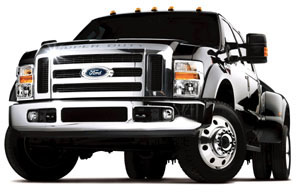 towing a hefty travel trailer, toy hauler or fifth-wheel. For those RV motorists, Ford claims to have the right trucks for the job, properly equipped to tow straight from the factory. If an RVer wants to tow a 24,500-lb fifth-wheel trailer, the 2008 Ford F450 Super Duty can handle it, boasting the best tow rating ever for a non-commercial-grade pickup truck. If it’s a conventional-hitch travel trailer to haul, the same truck can pull up to 16,000 lbs., again the best in its class.
towing a hefty travel trailer, toy hauler or fifth-wheel. For those RV motorists, Ford claims to have the right trucks for the job, properly equipped to tow straight from the factory. If an RVer wants to tow a 24,500-lb fifth-wheel trailer, the 2008 Ford F450 Super Duty can handle it, boasting the best tow rating ever for a non-commercial-grade pickup truck. If it’s a conventional-hitch travel trailer to haul, the same truck can pull up to 16,000 lbs., again the best in its class.